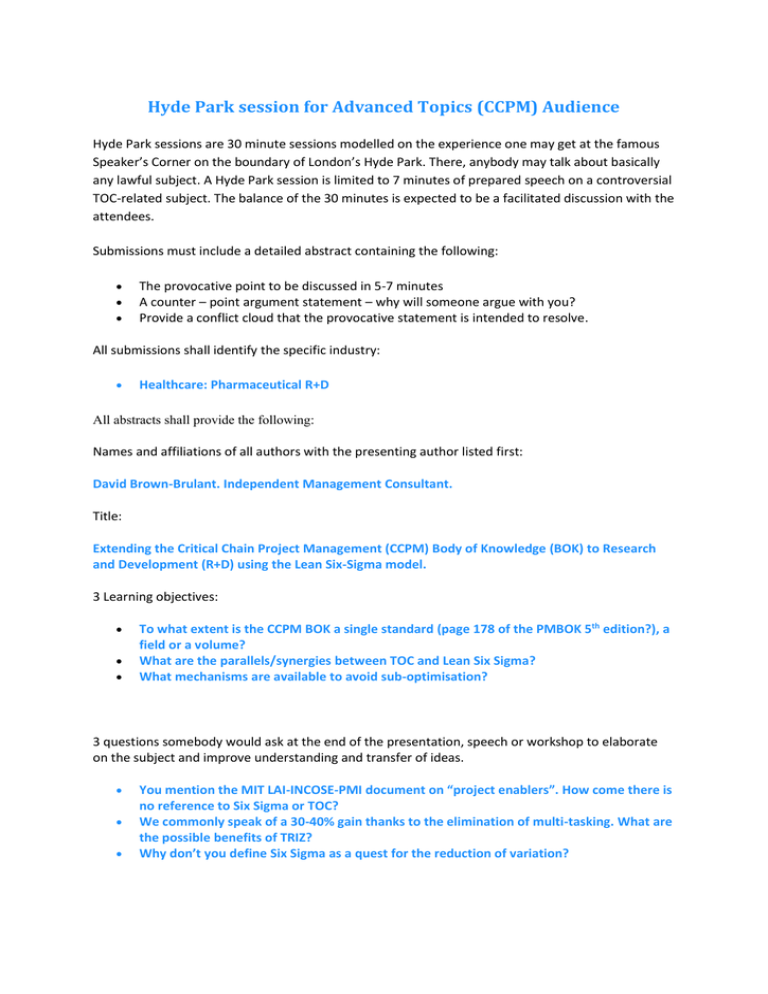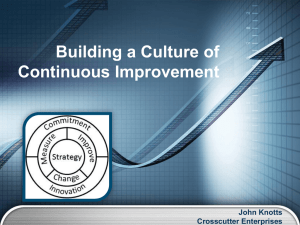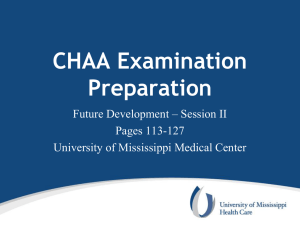(CCPM) Body of Knowledge (BOK) to Research and
advertisement

Hyde Park session for Advanced Topics (CCPM) Audience Hyde Park sessions are 30 minute sessions modelled on the experience one may get at the famous Speaker’s Corner on the boundary of London’s Hyde Park. There, anybody may talk about basically any lawful subject. A Hyde Park session is limited to 7 minutes of prepared speech on a controversial TOC-related subject. The balance of the 30 minutes is expected to be a facilitated discussion with the attendees. Submissions must include a detailed abstract containing the following: The provocative point to be discussed in 5-7 minutes A counter – point argument statement – why will someone argue with you? Provide a conflict cloud that the provocative statement is intended to resolve. All submissions shall identify the specific industry: Healthcare: Pharmaceutical R+D All abstracts shall provide the following: Names and affiliations of all authors with the presenting author listed first: David Brown-Brulant. Independent Management Consultant. Title: Extending the Critical Chain Project Management (CCPM) Body of Knowledge (BOK) to Research and Development (R+D) using the Lean Six-Sigma model. 3 Learning objectives: To what extent is the CCPM BOK a single standard (page 178 of the PMBOK 5th edition?), a field or a volume? What are the parallels/synergies between TOC and Lean Six Sigma? What mechanisms are available to avoid sub-optimisation? 3 questions somebody would ask at the end of the presentation, speech or workshop to elaborate on the subject and improve understanding and transfer of ideas. You mention the MIT LAI-INCOSE-PMI document on “project enablers”. How come there is no reference to Six Sigma or TOC? We commonly speak of a 30-40% gain thanks to the elimination of multi-tasking. What are the possible benefits of TRIZ? Why don’t you define Six Sigma as a quest for the reduction of variation? Provocative Point: Extending the Critical Chain Project Management (CCPM) Body of Knowledge(BOK) to Research and Development (R+D) using the Lean Six-Sigma model. At successive 15th anniversaries of “Critical Chain”1 and Projects in the fast lane”2 2012 and 2013 have been milestones for Critical Chain Project Management with the incorporation of the term into the Project Management Institutes BOK3, the output of a key joint document between three stakeholder institutes4 and an easy to understand implementation that addresses a common frustration of clients to the CCPM process5. Furthermore, in a standing on the shoulders of giants exercise6, we now have the key assumptions of the CCPM Body of Knowledge7. If R+D initially appear to be at the limits of the assumptions of CCPM, we know that R+D portfolios suffer as much as any other from excessive inventory dispersed across the value creation trail. We also know that the uncertain value of the inventory as well as the multi-tasking blurs accountability, encouraging an unhealthy tug of war between the functional departments, as well as frustration up and down the vertical chain of command8. Leach9,10 and Kendall11 have addressed this question over the past decade with regard to projects and project portfolios respectively by referring firstly to the effective application of the Project Management Institute Body of Knowledge but also to Lean Six-Sigma. It is the object of this paper is to spell out how lean six sigma methodology and tools can extend the application of CCPM in R+D as a combined win-win and without threat to the fundamental CCPM precepts. In his introductory Lean Six Sigma deployment address, Al Stroucken12 defines Lean Six Sigma as a common global platform and a collection of tools that will empower the company’s employees, improve decision speed, and reduce the gap between the company’s production and its client’s expectations, not unlike Viable Vision13 and entirely within the objective of running fast projects. The first reason why the Lean Six Sigma methodology is robust in R+D situations lies in the winning couplet analysis-action14: The 5 stage standard D(efine)M(esure)A(nalyse)I(mprove)C(ontrol) process15 (or its development successor D(efine)C(oncept)D(esign)O(ptimise)V(erify)) involve making explicit what is often otherwise guesswork or private intuition at every stage, especially at project selection: projects are chosen on the basis of a business case that is prioritised with regard to alternatives, vetted with regard to company strategy and found compelling to a panel of peers, not unlike a logic tree analysis. The projects are run along the lines of a zero flow cell16, or Toyota Production System “Obeya” around fast delivery17. Because the method creates conditions such that the individual project team member can contribute fully and the teams are often cross functional, Lean Six Sigma projects are able to take advantage of a large variety of opportunities across functional and organisational boundaries18. Let us detail the analysis strand: If lean is based on the elimination of non value add for the customer, the customer’s requirements are generally assumed simple, well understood and constant (!). The voice of customer evaluation exercise of the Define phase, possibly using quality function deployment, ensures that these are detailed, quantified and prioritised. Quality function deployment extends into the Measure or the Concept phase with benchmarking, a reasonable anchor for team efforts19 and a key input for the gate risk assessment. Pioneered in particular by Samsung20 and with considerable similarity to Evaporating Cloud analysis21, the use of TRIZ allows to remove waste from the ideation process. Lean Six-Sigma has inherited an impressive modelling capability (Multiple Regression, Discrete Event Simulation, Monte Carlo Simulation, and Reliability Calculations). These allow the team to: o Sort through the data, to determine what is important, where the bottleneck lies. o Evaluate cause-effect relations that allow the evaluation of possible solutions. o Propose the implementation of multiple solution paths to mitigate the impact of individual solution failure. Because Lean Six-Sigma pro-actively seeks to create a winning team cell through external steps (Project definition, Team selection, Project Sponsor and Project Coach nomination), not only does it reap the benefits of high team performance22, but the project becomes a legitimate magnet for other resources within the company. So not only does the project benefit from a formal escalation process but it is also able to access informal help and project resourcing ceases to be a limiting issue. The cell has free rein to use SMED, concurrent engineering, Kaizen events (or brilliant ideas) to accelerate project process steps and it would be straightforward to develop a specific visual management scheme or gate process to ensure accountability. There is no reason why the team would not produce a CCPM Gantt and fever chart. But the trump card of the cell is that it is an effective solution to the perennial problem of process sub-optimisation6 and the team is able to locate and support the project constraint to ensure a great outcome for the project. Bibliography: 1. Eliyahu Goldratt, Critical Chain, 1997 2. Robert Newbold. Project Management in the fast lane. Applying the theory of constraints, 1988. 3. PMI Institute, PMBOK Guide 5th edition, 2013 4. Oehmen et al , LAI MIT-PMI-INCOSE, - The Guide to Lean Enablers for Managing Engineering Programs, 2012 5. Holt J, Visual Project Management: Seeing how to get things done. Technology and Management program Washington State University (youtube), 2012. 6. Goldratt E., Standing on the Shoulders of Giants: Production concepts versus production applications. The Hitachi Tool Engineering example, 2008 7. Schragenheim E, Discussing the boundaries of CCPM, 2013 8. Scherer A., Be Fast or Be Gone: Racing the Clock with Critical Chain Project Management, 2011 9. Leach L., Advanced Project Institute, Critical Chain Project Management Improves Project Performance, 1997. 10. Leach L., Lean Project Management, 2005 11. Kendall G, Austin K., Advanced Multi-Project Management 2013 12. Stroucken, A: Initial CEO Webcast Address to Owens-Illinois Lean Six-Sigma Practitioners 2008 13. Kendall G., Viable Vision: Transforming Total Sales into Net Profits, 2005. 14. Morris E. (documentary film) http://www.youtube.com/watch?v=KkQk50qtTwo The Fog of War: Eleven Lessons from the Life of Robert S. McNamara, 2003. 15. Harry M., The Vision of Six Sigma: A Roadmap for Breakthrough, Sigma Publishing Company, Phoenix, Arizona,1994 16. Maaseidvaagg L., Lean Work Cell Design: Taking the Lessons of Cellular Manufacturing into Service Organizations", 2013 17. George M., Lean Six Sigma : Combining Six Sigma Quality with Lean Production Speed: Combining Six Sigma Quality with Lean Production Speed, , McGraw Hill, 2002 18. Sproull B., Nelson B “Epiphanized: Interpreting Theory of Constraints, Lean and Six Sigma”, 2012 19. Lovallo D., Kahneman D., Harvard Business Review, “Delusions of Success: How Optimism Undermines Executives Decisions”, 2003 20. http://www.forbes.com/sites/haydnshaughnessy/2013/03/07/why-is-samsung-such-aninnovative-company/2/ 21. Fedurko J, Looking into UDE Clouds –how to get them right. 2013 22. Katzenbach J, Smith D., The wisdom of teams. Creating the High Performance Organization, 1993. Counter Point 1by CCPM enthusiast: You should stick with a standard CCPM approach. Buy some CCPM software, enter the templates and away you go! Counter Point 2 by R+D manager: You should buy some software that takes into account the CCPM approach and flex the existing functional department approach. Conflict Cloud







